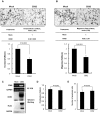Expression of CD82 in human trophoblast and its role in trophoblast invasion
- PMID: 22679510
- PMCID: PMC3367946
- DOI: 10.1371/journal.pone.0038487
Expression of CD82 in human trophoblast and its role in trophoblast invasion
Abstract
Background: Well-controlled trophoblast invasion at maternal-fetal interface is a critical event for the normal development of placenta. CD82 is a member of transmembrane 4 superfamily, which showed important role in inhibiting tumor cell invasion and migration. We surmised that CD82 are participates in trophoblast differentiation during placenta development.
Methodology/principal findings: CD82 was found to be strongly expressed in human first trimester placental villous and extravillous trophoblast cells as well as in trophoblast cell lines. To investigate whether CD82 plays a role in trophoblast invasion and migration, we further utilized human villous explants culture model on matrigel and invasion/migration assay of trophoblast cell line HTR8/SVneo. CD82 siRNA significantly promoted outgrowth of villous explants in vitro (P<0.01), as well as invasion and migration of HTR8/SVneo cells (P<0.05), whereas the trophoblast proliferation was not affected. The enhanced effect of CD82 siRNA on invasion and migration of trophoblast cells was found associated with increased gelatinolytic activities of matrix metalloproteinase MMP9 while over-expression of CD82 markedly decreased trphoblast cell invasion and migration as well as MMP9 activities.
Conclusions/significance: These findings suggest that CD82 is an important negative regulator at maternal-fetal interface during early pregnancy, inhibiting human trophoblast invasion and migration.
Conflict of interest statement
Figures





Similar articles
-
Expression of Gadd45α in human early placenta and its role in trophoblast invasion.Placenta. 2014 Jun;35(6):370-7. doi: 10.1016/j.placenta.2014.03.020. Epub 2014 Apr 12. Placenta. 2014. PMID: 24755561
-
The chemokine CXCL6 restricts human trophoblast cell migration and invasion by suppressing MMP-2 activity in the first trimester.Hum Reprod. 2013 Sep;28(9):2350-62. doi: 10.1093/humrep/det258. Epub 2013 Jun 28. Hum Reprod. 2013. PMID: 23814098
-
The cytokine gene CXCL14 restricts human trophoblast cell invasion by suppressing gelatinase activity.Endocrinology. 2009 Dec;150(12):5596-605. doi: 10.1210/en.2009-0570. Epub 2009 Oct 15. Endocrinology. 2009. PMID: 19833716
-
Potential role of epigenetic mechanisms in regulation of trophoblast differentiation, migration, and invasion in the human placenta.Cell Adh Migr. 2016 Mar 3;10(1-2):126-35. doi: 10.1080/19336918.2015.1098800. Epub 2016 Jan 8. Cell Adh Migr. 2016. PMID: 26745760 Free PMC article. Review.
-
Happy feet: the key roles of podosomes and invadopodia in trophoblast invasion at the maternal-fetal interface.Front Endocrinol (Lausanne). 2025 May 30;16:1576732. doi: 10.3389/fendo.2025.1576732. eCollection 2025. Front Endocrinol (Lausanne). 2025. PMID: 40519515 Free PMC article. Review.
Cited by
-
Downregulation of CD9 in keratinocyte contributes to cell migration via upregulation of matrix metalloproteinase-9.PLoS One. 2013 Oct 16;8(10):e77806. doi: 10.1371/journal.pone.0077806. eCollection 2013. PLoS One. 2013. PMID: 24147081 Free PMC article.
-
Advanced Maternal Age-associated SIRT1 Deficiency Compromises Trophoblast Epithelial-Mesenchymal Transition through an Increase in Vimentin Acetylation.Aging Cell. 2021 Oct;20(10):e13491. doi: 10.1111/acel.13491. Epub 2021 Oct 3. Aging Cell. 2021. PMID: 34605151 Free PMC article.
-
N-cadherin knockdown leads to disruption of trophoblastic and endothelial cell interaction in a 3D cell culture model - New insights in trophoblast invasion failure.Cell Adh Migr. 2018 May 4;12(3):259-270. doi: 10.1080/19336918.2017.1386822. Epub 2017 Dec 12. Cell Adh Migr. 2018. PMID: 29231798 Free PMC article.
-
Aquaporin 3 promotes human extravillous trophoblast migration and invasion.Reprod Biol Endocrinol. 2021 Mar 29;19(1):49. doi: 10.1186/s12958-021-00726-z. Reprod Biol Endocrinol. 2021. PMID: 33781292 Free PMC article.
-
Research progress of E3 ubiquitin ligase regulating biological behavior of human placental trophoblast cells.Front Endocrinol (Lausanne). 2023 Apr 14;14:1124041. doi: 10.3389/fendo.2023.1124041. eCollection 2023. Front Endocrinol (Lausanne). 2023. PMID: 37168980 Free PMC article. Review.
References
Publication types
MeSH terms
Substances
LinkOut - more resources
Full Text Sources
Other Literature Sources
Miscellaneous

